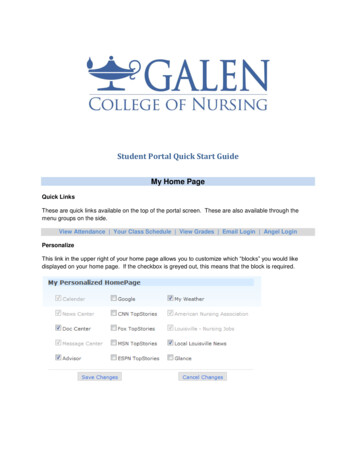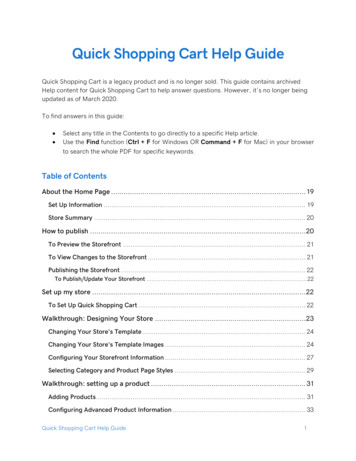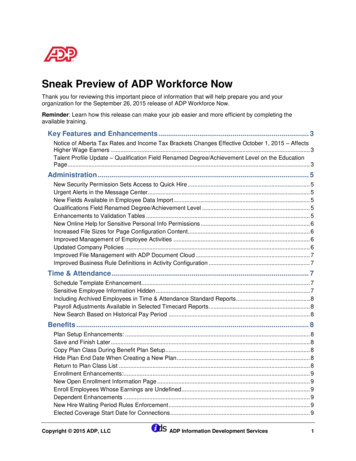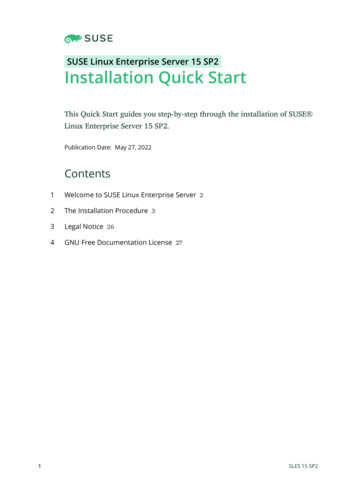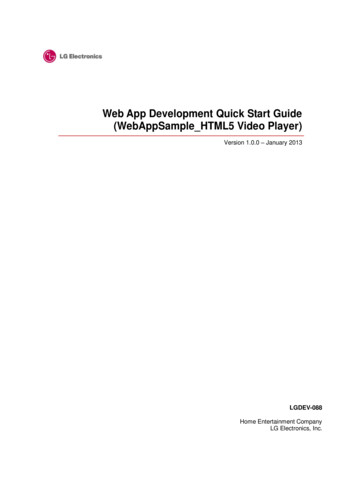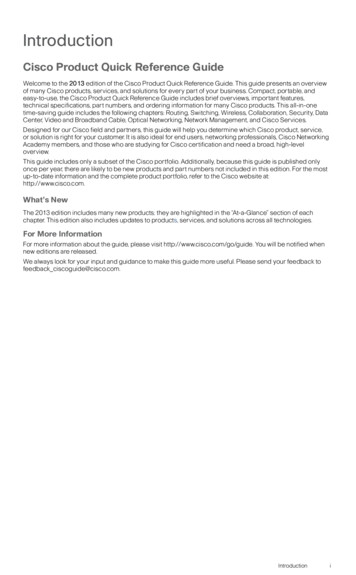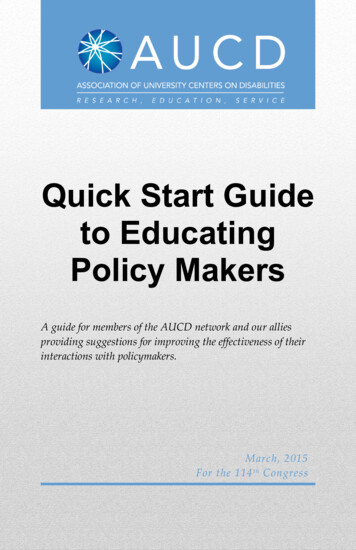
Transcription
Quick Start Guideto EducatingPolicy MakersA guide for members of the AUCD network and our alliesproviding suggestions for improving the effectiveness of theirinteractions with policymakers.March, 2015For the 114 th Congress
Contributing StaffKim Musheno; Director of Public PolicyRachel Patterson, MA; Policy ManagerW. Benjamin Jackson III, JD; Disability Policy LeadershipFellowPublicationAssociation of University Centers on Disabilities1100 Wayne Avenue, Suite 1000Silver Spring, MD 20910www.aucd.org aucdinfo@aucd.org
Table of ContentsPurpose of this Guide .1What is Federal Advocacy? .1Lobbying vs. Educating.2Legislative Branch: Congress .3Budget and Appropriations Process .5Administrative Branch .7Additional Resources .13
Purpose of this GuideThe purpose of this guide is to provide members of theAUCD network and its allies suggestions for improvingthe effectiveness of their interactions with policymakers.What is Federal Advocacy?Simply put, federal advocacy is influencing any federalpublic policy. This includes legislation being developed,amending current laws/ the lawȃs correspondingregulations, federal guidance or policy positions, and thefederal funding or appropriations for the programswithin the laws. Policies also include judicial oversightthrough the Supreme Court. This guide will focus on theU.S. Congress and the Administration.Executive BranchLegislative BranchPresident &AdministrationCongressHouse & SenateJudicial BranchCourts1
In order to be good at advocating, it is helpful tounderstand the legislative and regulatory processes, whothe key policymakers are, the political climate, and thekey policy issues for the current Congress andAdministration.Lobbying vs. EducatingMembers of the AUCD Network have a Congressionalmandate to educate policy makers. Some AUCD networkmembers worry that efforts to educate will be inviolation of laws regarding federal lobbying, howeverthere are important differences between lobbying andeducating.Lobbying is an attempt to influence any legislation bycommunicating with a policymaker and referring to orreflecting on specific legislation or regulationencouraging others to take action on a bill. Lobbyingdoes not include non-partisan analysis, study, orresearch, or the communication of research findings tothe general public, officials, or governmental bodies.The Developmental Disabilities Assistance and Bill ofRights Act (DD Act) mandates UCEDD programs toeducate policymakers. Specifically, it says ȄUniversityCenters must strengthen and increase the capacity ofstates and communities to achieve the purposes of theAct, including the analysis of public policy in areas thataffect or could affect, either positively or negatively,individuals with developmental disabilities and their2
families (Purpose, Section 101(b)).ȅ The DD Act furtherrequires UCEDD staff to: Advise federal, state, and communitypolicymakersProvide training and technical assistance forpolicymakersConduct research, including the analysis ofpublic policyDisseminate information and serve as a nationaland international resource that include specificsubstantive areas of expertiseServe as a research-based resource for federal andstate policymakersLegislative Branch: CongressHow a Bill Becomes a LawThe following steps are required for a Bill tobecome a Law: Introduced by Member of CongressSent to Committee/SubcommitteeHearings and markups heldHouse or Senate debatesConference Committee meetsHouse and Senate approve compromisePresident signs into Law3
Hereȃs the process in a diagram0Final billHowever, we all know that the steps are a little morecomplicated than that. There are many steps in betweenand every step is complicated by the political context,timing, cost, individual relationships, and outsideinfluences, to name a few. This is why you have AUCD4
policy staff! AUCD staff monitor the federal policy issueswith and for you and will inform the network when thetiming is right to influence individual policies.The most important thing for you to know is that you arethe expert when it comes to many important issues thatimpact individuals with disabilities, families, andcommunities; policymakers want the research results andevidence-based information you have to offer. AUCDmay request your help when expert witnesses are neededfor hearings or when we get requests for specific data orresearch findings. If you have completed a researchproject that you think might inform policymakers, pleaseshare it with AUCD staff as well as your congressionaldelegation.Budget and Appropriations ProcessThe budget and appropriations process is a separateprocess and works a little differently than the way anauthorizing bill becomes a law.Once a bill becomes a law, the AppropriationsCommittee is responsible for deciding how much moneywill be provided for the programs or activitiesauthorized by the law. The Budget Committee writes anoverall budget blueprint that decides how the federalgovernment will spend the revenues it brings in throughtaxes. Here are the steps and a general timeline that theBudget Act provides to guide Congress through thisprocess:5
President submits budget request to Congress –1st Monday in FebruaryHouse and Senate create separate budgets orbudget resolutions – March-AprilConcurrent Budget Resolution is due by April 15Budget Committees provide allocations (called302(b)) to 13 appropriations subcommitteesHouse and Senate complete action on 13appropriations bills in September and thePresident signs them into lawA new fiscal yearMandatory spending refersbegins – October 1to spending enacted by law,Unfortunately, thisbut not dependent on anprocess and theseannual or periodictimelines are rarely met,appropriation bill. Mostand in the past severalmandatory spending consistsyears, none of the 13of transfer payments andwelfare benefits such asannual appropriationsSocial Security benefits,bills were signed intoMedicare, and Medicaid.law. In the case of anybill not passing byOctober 1/ a Ȅcontinuing resolutionȅ must be agreed to inorder to keep the program going until a bill is finallypassed. Sometimes, several or all of the bills are puttogether and passed in an Ȅomnibusȅ bill.This year, it is expected that the Budget Committees willprovide reconciliation instructions to the variousauthorizing committees; that is, they will ask committeesto make changes to mandatory programs that will result6
in enough savings to meet the overall budget resolutionnumber.Administrative BranchAUCD doesnȃt just work with Congress! We also workwith the Administration: the President and the Cabinetleaders. The Administration is responsible forimplementing laws and providing oversight. ThePresident also has the power to veto laws and toinfluence the public through the Ȅbully pulpit;ȅ that isthrough his access to the media and other news outlets.Most importantly, the Administration writes theregulations that implement the laws. After a law ispassed or renewed, the administering agency willdevelop rules that provide more details about how thelaw will work in the real world. AUCD often providesinput into the regulations as they being developed.Again, Administration officials appreciate the help ofexperts Ȅin the fieldȅ who understand how the laws canand should work at the state and local levels. The processfor developing rules is generally as follows: Advocates and experts meet with federal officialsAdvanced Notice of Proposed Rulemaking(ANPRM) the agency accepts public commentsand holds meetingsNotice of Proposed Rulemaking (NPRM) morecomments/meetings7
Final review at Office of Management and Budget(OMB) there may be more comments/meetingsat this stage, but not alwaysFinal Rule is publishedThe Cabinet agencies AUCD works most closely with arethe Departments of Health and Human Services (HHS),Justice (DOJ), Education (ED), Labor (DOL),Transportation (DOT), and Housing and UrbanDevelopment (HUD).The DD Act programs, including UCEDDs, areadministered through the Administration on Intellectualand Developmental Disabilities (AAIDD) within theAdministration on Community Living (ACL) within theDepartment of Health and Human Services (HHS).The LENDs are administered through the Maternal andChild Health Bureau (MCHB) within the HealthResources Services Administration (HRSA) within HHS.The IDDRCs are administered through the NationalInstitutes for Child Health and Human Development(NICHD) within the National Institutes of Health (NIH)within HHS.So, be aware that AUCD may be asking networkmembers for specific expertise and guidance as theseRules are being written.8
Congressional CommitteesIt is important to get to know who the members are oncongressional committees that have jurisdiction overimportant disability issues and programs. Following area list of key committees and their current leadership.Key Senate Committeeso Appropriations Thad Cochran, MS Barbara Mikulski, MDo Labor-Health-Education Subcommittee Roy Blunt, MO Patty Murray, WAo Budget Michael Enzi, WY Bernie Sanders, VTo Finance Orrin Hatch, UT Ron Wyden, ORo Health, Education, Labor & Pension Lamar Alexander, TN Patty Murray, WA9
Key House Committeeso Appropriations Harold Rogers, KY Nita Lowey, NYo Labor-Health-Education Subcommittee Tom Cole, OK Rosa DeLauro, NYo Budget Tom Price, GA Chris Van Hollen, MDo Education & Workforce John Kline, MN Bobby Scott, VAo Energy and Commerce Fred Upton, MI Frank Pallone, NJo Ways and Means Paul Ryan, WI Sander Levin, MI10
Appropriations CommitteesThe most important committees for you to know are theones that make decisions about funding for AUCDnetwork programs. These are the House and SenateAppropriations Subcommittees for Labor, HHS, ED andRelated Agencies (L-HHS-ED). They are listed in fullhere:House L-HHS-ED Appropriations SubcommitteeMajorityTom Cole, OKMike Simpson, IDSteve Womack, ARChuck Fleischmann, TNDr. Andy Harris, MDMartha Roby, ALCharlie Dent, PAScott Rigell, VAMinorityRosa DeLauro, CTLucille Roybal-Allard, CABarbara Lee, CAChaka Fattah, PASenate L-HHS-ED Appropriations SubcommitteeMajority MembersChairman Roy Blunt, MS Jerry Moran, KSRichard Shelby, ALThad Cochran, MSLamar Alexander, TNLindsey Graham, SCMark Kirk, ILBill Cassidy, LAShelley Captio, WVJames Lankford, OK11
Minority MembersRanking Member Patty Murray, WARichard Durbin, ILJack Reed, RIBarbara Mikulski, MDJeanne Shaheen, NHJeff Merlkey, ORBrian Schatz, HITammy Baldwin, WIBudget Control ActIn a response to the debt-ceiling crisis of 2011, the BudgetControl Act of 2011 was passed into law. The BudgetControl Act cut discretionary funding, reducingspending by 1.2 trillion over the next ten years. The lawalso introduced a discretionary spending cap that willlast until the end of the decade. If the spending caps areexceeded there is an across-the-board cut (known assequester) of discretionary spending (with a permissibleexemption for military pay) to eliminate the excessspending. The discretionary caps are written into the lawand can only be changed by enactment of futurelegislation. The Budget Control Act affects AUCDȃsadvocacy work and shapes the fiscal environment for thefederal government for the foreseeable future.12
Additional Resources AUCD: www.aucd.orgAUCDȃs public policy pages: www.aucd.org, clickȄpublic policyȅThis is the home for all of AUCDȃs policy-relatedinitiatives including Disability Policy News InBrief, links to current policy actions taken byAUCD, and frequently updated resources.AUCD Action Center:http://cqrcengage.com/aucd/homeThe interactive online Action Center containsAUCDȃs action alerts with sample letters to makeit easy to contact Congress, a full congressionaldirectory, and information about where to vote.Health Hub: frequently updated information onthe health reform law including fundingannouncements.HCBS Advocacy: a platform for the aging anddisability communities to post information andresources regarding the new HCBS settings ruleand steps each state is making to comply with thenew rule.Disability Policy News In Brief: a weekly updateon disability policy news. Subjects cover the rangeof our key issues from budget and appropriationsto education and employment.Tuesdays with Liz: Disability Policy for All: aYouTube video newsletter in a fun engagingformat for beginners to federal policy issues andadvocacy.13
Disability Policy Seminar: a yearly event wherestakeholders (self-advocates, parents and familymembers of an individuals with disabilities,members of disability organizations, and others)are educated on priorities of the I/DD communityand make Hill visits. The Seminar resource pagecontains all the fact sheets and other resourcesavailable to attendees and those interested indisability policy.Consortium for Citizens with Disabilities (CCD): acoalition of approximately 100 national disabilityorganizations working together to advocate fornational public policy that ensures the selfdetermination, independence, empowerment,integration, and inclusion of children and adultswith disabilities in all aspects of society.AUCDȃs Public Policy Priorities: AUCD developsits policy priorities at the beginning of eachsession of Congress. The goals are developed bythe Public Policy Committee with input from thenetwork and then approved by the Board ofDirectors.To keep up with how AUCDȃs policy agenda isprogressing, consider subscribing to Disability PolicyNews In Brief. This brief weekly e-newslettersummarizes what happened the prior week as well astells you what to watch for in the days and weeks ahead.14
We hope this quick start guide to educating policymakers was helpful! Please feel welcome to ask anyquestions or provide comments to AUCDȃs Director ofPublic Policy, Kim Musheno at kmusheno@aucd.org.15
AUCDASSOCIATION OF UNIVERSITY CENTERS ON DISABILITIESRESEARCH ,EDUCATION,SERVICE16
Barbara Mikulski, MD o Labor-Health-Education Subcommittee Roy Blunt, MO Patty Murray, WA o Budget Michael Enzi, WY Bernie Sanders, VT o Finance Orrin Hatch, UT Ron Wyden, OR o Health, Education, L


